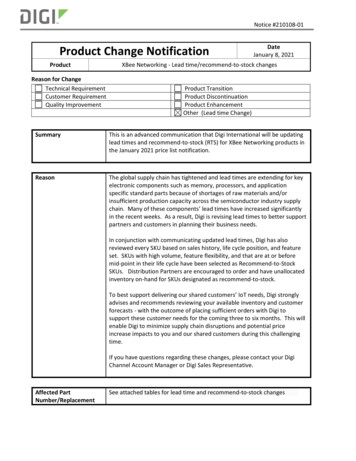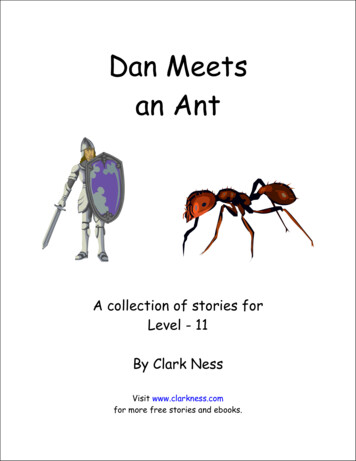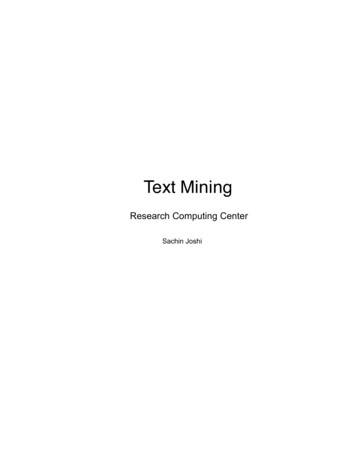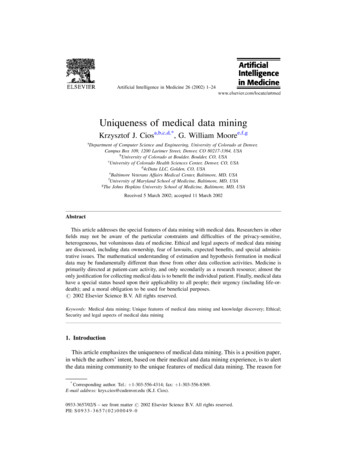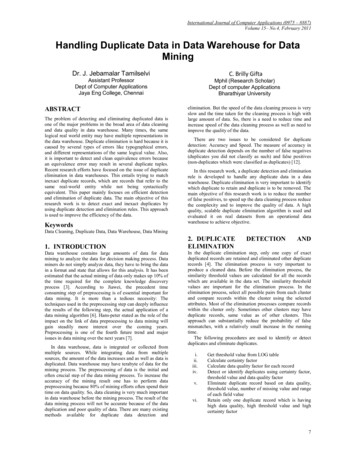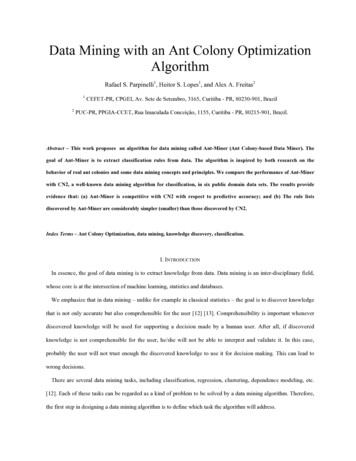
Transcription
1Data Mining with an Ant Colony OptimizationAlgorithmRafael S. Parpinelli1, Heitor S. Lopes1, and Alex A. Freitas212CEFET-PR, CPGEI, Av. Sete de Setembro, 3165, Curitiba - PR, 80230-901, BrazilPUC-PR, PPGIA-CCET, Rua Imaculada Conceição, 1155, Curitiba - PR, 80215-901, Brazil.Abstract – This work proposes an algorithm for data mining called Ant-Miner (Ant Colony-based Data Miner). Thegoal of Ant-Miner is to extract classification rules from data. The algorithm is inspired by both research on thebehavior of real ant colonies and some data mining concepts and principles. We compare the performance of Ant-Minerwith CN2, a well-known data mining algorithm for classification, in six public domain data sets. The results provideevidence that: (a) Ant-Miner is competitive with CN2 with respect to predictive accuracy; and (b) The rule listsdiscovered by Ant-Miner are considerably simpler (smaller) than those discovered by CN2.Index Terms – Ant Colony Optimization, data mining, knowledge discovery, classification.I. INTRODUCTIONIn essence, the goal of data mining is to extract knowledge from data. Data mining is an inter-disciplinary field,whose core is at the intersection of machine learning, statistics and databases.We emphasize that in data mining – unlike for example in classical statistics – the goal is to discover knowledgethat is not only accurate but also comprehensible for the user [12] [13]. Comprehensibility is important wheneverdiscovered knowledge will be used for supporting a decision made by a human user. After all, if discoveredknowledge is not comprehensible for the user, he/she will not be able to interpret and validate it. In this case,probably the user will not trust enough the discovered knowledge to use it for decision making. This can lead towrong decisions.There are several data mining tasks, including classification, regression, clustering, dependence modeling, etc.[12]. Each of these tasks can be regarded as a kind of problem to be solved by a data mining algorithm. Therefore,the first step in designing a data mining algorithm is to define which task the algorithm will address.
2In this paper we propose an Ant Colony Optimization (ACO) algorithm [10] [11] for the classification task ofdata mining. In this task the goal is to assign each case (object, record, or instance) to one class, out of a set ofpredefined classes, based on the values of some attributes (called predictor attributes) for the case.In the context of the classification task of data mining, discovered knowledge is often expressed in the form ofIF-THEN rules, as follows:IF conditions THEN class .The rule antecedent (IF part) contains a set of conditions, usually connected by a logical conjunction operator(AND). In this paper we will refer to each rule condition as a term, so that the rule antecedent is a logicalconjunction of terms in the form: IF term1 AND term2 AND . Each term is a triple attribute, operator, value ,such as Gender female .The rule consequent (THEN part) specifies the class predicted for cases whose predictor attributes satisfy all theterms specified in the rule antecedent. From a data mining viewpoint, this kind of knowledge representation hasthe advantage of being intuitively comprehensible for the user, as long as the number of discovered rules and thenumber of terms in rule antecedents are not large.To the best of our knowledge, the use of ACO algorithms [9] [10] [11] for discovering classification rules, in thecontext of data mining, is a research area still unexplored. Actually, the only ant algorithm developed for datamining that we are aware of is an algorithm for clustering [17], which is a data mining task very different from theclassification task addressed in this paper.We believe that the development of ACO algorithms for data mining is a promising research area, due to thefollowing reason. ACO algorithms involve simple agents (ants) that cooperate with one another to achieve anemergent, unified behavior for the system as a whole, producing a robust system capable of finding high-qualitysolutions for problems with a large search space. In the context of rule discovery, an ACO algorithm has the abilityto perform a flexible, robust search for a good combination of terms (logical conditions) involving values of thepredictor attributes.The rest of this paper is organized as follows. Section II presents a brief overview of real ant colonies. SectionIII discusses the main characteristics of ACO algorithms. Section IV introduces the ACO algorithm fordiscovering classification rules proposed in this work. Section V reports computational results evaluating theperformance of the proposed algorithm. In particular, in that section we compare the proposed algorithm with
3CN2, a well-known algorithm for classification-rule discovery, across six data sets. Finally, Section VI concludesthe paper and points directions for future research.II. SOCIAL INSECTS AND REAL ANT COLONIESIn a colony of social insects, such as ants, bees, wasps and termites, each insect usually performs its own tasksindependently from other members of the colony. However, the tasks performed by different insects are related toeach other in such a way that the colony, as a whole, is capable of solving complex problems through cooperation[2]. Important, survival-related problems such as selecting and picking up materials, finding and storing food,which require sophisticated planning, are solved by insect colonies without any kind of supervisor or centralizedcontroller. This collective behavior which emerges from a group of social insects has been called “swarmintelligence” [2].In this paper we are interested in a particular behavior of real ants, namely the fact that they are capable offinding the shortest path between a food source and the nest (adapting to changes in the environment) without theuse of visual information [9]. This intriguing ability of almost-blind ants has been extensively studied byethologists. They discovered that, in order to exchange information about which path should be followed, antscommunicate with one another by means of pheromone (a chemical substance) trails. As ants move, a certainamount of pheromone is dropped on the ground, marking the path with a trail of this substance. The more antsfollow a given trail, the more attractive this trail becomes to be followed by other ants. This process can bedescribed as a loop of positive feedback, in which the probability that an ant chooses a path is proportional to thenumber of ants that have already passed by that path [9] [11] [23].When an established path between a food source and the ants’ nest is disturbed by the presence of an object, antssoon will try to go around the obstacle. Firstly, each ant can choose to go around to the left or to the right of theobject with a 50%-50% probability distribution. All ants move roughly at the same speed and deposit pheromonein the trail at roughly the same rate. Therefore, the ants that (by chance) go around the obstacle by the shortest pathwill reach the original track faster than the others that have followed longer paths to circumvent the obstacle. As aresult, pheromone accumulates faster in the shorter path around the obstacle. Since ants prefer to follow trails withlarger amounts of pheromone, eventually all the ants converge to the shorter path.
4III. ANT COLONY OPTIMIZATIONAn Ant Colony Optimization algorithm (ACO) is essentially a system based on agents which simulate thenatural behavior of ants, including mechanisms of cooperation and adaptation. In [10] the use of this kind ofsystem as a new metaheuristic was proposed in order to solve combinatorial optimization problems. This newmetaheuristic has been shown to be both robust and versatile – in the sense that it has been successfully applied toa range of different combinatorial optimization problems [11].ACO algorithms are based on the following ideas: Each path followed by an ant is associated with a candidate solution for a given problem. When an ant follows a path, the amount of pheromone deposited on that path is proportional to the qualityof the corresponding candidate solution for the target problem. When an ant has to choose between two or more paths, the path(s) with a larger amount of pheromone havea greater probability of being chosen by the ant.As a result, the ants eventually converge to a short path, hopefully the optimum or a near-optimum solution forthe target problem, as explained before for the case of natural ants.In essence, the design of an ACO algorithm involves the specification of [2]: An appropriate representation of the problem, which allows the ants to incrementally construct/modifysolutions through the use of a probabilistic transition rule, based on the amount of pheromone in the trailand on a local, problem-dependent heuristic. A method to enforce the construction of valid solutions, that is, solutions that are legal in the real-worldsituation corresponding to the problem definition. A problem-dependent heuristic function (h ) that measures the quality of items that can be added to thecurrent partial solution. A rule for pheromone updating, which specifies how to modify the pheromone trail (t ). A probabilistic transition rule based on the value of the heuristic function (h ) and on the contents of thepheromone trail (t ) that is used to iteratively construct a solution.Artificial ants have several characteristics similar to real ants, namely: Artificial ants have a probabilistic preference for paths with a larger amount of pheromone.
5 Shorter paths tend to have larger rates of growth in their amount of pheromone. The ants use an indirect communication system based on the amount of pheromone deposited on each path.IV. ANT-MINER: A NEW ACO ALGORITHM FOR DATA MININGIn this section we discuss in detail our proposed Ant Colony Optimization algorithm for the discovery ofclassification rules, called Ant-Miner. The section is divided into five subsections, namely: a general description ofAnt-Miner, heuristic function, rule pruning, pheromone updating, and use of the discovered rules for classifyingnew cases.A. A General Description of Ant-MinerIn an ACO algorithm each ant incrementally constructs/modifies a solution for the target problem. In our casethe target problem is the discovery of classification rules. As discussed in the introduction, each classification rulehas the form:IF term1 AND term2 AND . THEN class .Each term is a triple attribute, operator, value , where value is a value belonging to the domain of attribute. Theoperator element in the triple is a relational operator. The current version of Ant-Miner copes only with categoricalattributes, so that the operator element in the triple is always “ ”. Continuous (real-valued) attributes arediscretized in a preprocessing step.A high-level description of Ant-Miner is shown in Algorithm I. Ant-Miner follows a sequential coveringapproach to discover a list of classification rules covering all, or almost all, the training cases. At first, the list ofdiscovered rules is empty and the training set consists of all the training cases. Each iteration of the WHILE loopof Algorithm I, corresponding to a number of executions of the REPEAT-UNTIL loop, discovers oneclassification rule. This rule is added to the list of discovered rules, and the training cases that are correctlycovered by this rule (i.e., cases satisfying the rule antecedent and having the class predicted by the ruleconsequent) are removed from the training set. This process is iteratively performed while the number ofuncovered training cases is greater than a user-specified threshold, called Max uncovered cases.Each iteration of the REPEAT-UNTIL loop of Algorithm I consists of three steps, comprising rule construction,
6rule pruning, and pheromone updating, detailed as follows.First, Antt starts with an empty rule, that is, a rule with no term in its antecedent, and adds one term at a time toits current partial rule. The current partial rule constructed by an ant corresponds to the current partial pathfollowed by that ant. Similarly, the choice of a term to be added to the current partial rule corresponds to thechoice of the direction in which the current path will be extended. The choice of the term to be added to the currentpartial rule depends on both a problem-dependent heuristic function (h ) and on the amount of pheromone (t )associated with each term, as will be discussed in detail in the next subsections. Antt keeps adding one-term-at-atime to its current partial rule until one of the following two stopping criteria is met: Any term to be added to the rule would make the rule cover a number of cases smaller than a user-specifiedthreshold, called Min cases per rule (minimum number of cases covered per rule). All attributes have already been used by the ant, so that there is no more attributes to be added to the ruleantecedent. Note that each attribute can occur only once in each rule, to avoid invalid rules such as “IF (Sex male) AND (Sex female) .”.
7ALGORITHM I: A HIGH-LEVEL DESCRIPTION OF ANT-MINERTrainingSet {all training cases};DiscoveredRuleList [ ]; /* rule list is initialized with an empty list */WHILE (TrainingSet Max uncovered cases)t 1; /* ant index */j 1; /* convergence test index */Initialize all trails with the same amount of pheromone;REPEATAntt starts with an empty rule and incrementally constructs a classification rule Rt by adding one term at a time to thecurrent rule;Prune rule Rt;Update the pheromone of all trails by increasing pheromone in the trail followed by Antt (proportional to the quality ofRt) and decreasing pheromone in the other trails (simulating pheromone evaporation);IF (Rt is equal to Rt – 1) /* update convergence test */THEN j j 1;ELSE j 1;END IFt t 1;UNTIL (i No of ants) OR (j No rules converg)Choose the best rule Rbest among all rules Rt constructed by all the ants;Add rule Rbest to DiscoveredRuleList;TrainingSet TrainingSet - {set of cases correctly covered by Rbest};END WHILESecond, rule Rt constructed by Antt is pruned in order to remove irrelevant terms, as will be discussed later. Forthe moment, we only mention that these irrelevant terms may have been included in the rule due to stochasticvariations in the term selection procedure and/or due to the use of a shortsighted, local heuristic function - whichconsiders only one-attribute-at-a-time, ignoring attribute interactions.Third, the amount of pheromone in each trail is updated, increasing the pheromone in the trail followed by Antt(according to the quality of rule R t) and decreasing the pheromone in the other trails (simulating the pheromoneevaporation). Then another ant starts to construct its rule, using the new amounts of pheromone to guide its search.
8This process is repeated until one of the following two conditions is met: The number of constructed rules is equal to or greater than the user-specified threshold No of ants. The current Antt has constructed a rule that is exactly the same as the rule constructed by the previousNo rules converg – 1 ants, where No rules converg stands for the number of rules used to testconvergence of the ants. The term convergence is defined in Section V.Once the REPEAT-UNTIL loop is completed, the best rule among the rules constructed by all ants is added tothe list of discovered rules, as mentioned earlier, and the system starts a new iteration of the WHILE loop, byreinitializing all trails with the same amount of pheromone.It should be noted that, in a standard definition of ACO [10], a population is defined as the set of ants that buildsolutions between two pheromone updates. According to this definition, in each iteration of the WHILE loop AntMiner works with a population of a single ant, since pheromone is updated after a rule is constructed by an ant.Therefore, strictly speaking, each iteration of the WHILE loop of Ant-Miner has a single ant which performs manyiterations. Note that different iterations of the WHILE loop correspond to different populations, since eachpopulation's ant tackles a different problem, that is, a different training set. However, in the text we refer to the t-thiteration of the ant as a separate ant, called the t-th ant (Antt), in order to simplify the description of the algorithm.From a data mining viewpoint the core operation of Ant-Miner is the first step of the REPEAT-UNTIL loop ofAlgorithm I, in which the current ant iteratively adds one term at a time to its current partial rule. Let termij be arule condition of the form Ai Vij, where Ai is the i-th attribute and Vij is the j-th value of the domain of A i. Theprobability that termij is chosen to be added to the current partial rule is given by Equation (1):Pij h ij t ij (t)abii 1j 1( xi  h ij t ij (t))(1)where: h ij is the value of a problem-dependent heuristic function for termij. The higher the value of h ij, the morerelevant for classification the termij is, and so the higher its probability of being chosen. The function thatdefines the problem-dependent heuristic value is based on information theory, and it will be discussed in thenext section. t ij(t) is the amount of pheromone associated with termij at iteration t, corresponding to the amount of
9pheromone currently available in the position i,j of the path being followed by the current ant. The better thequality of the rule constructed by an ant, the higher the amount of pheromone added to the trail segmentsvisited by the ant. Therefore, as time goes by, the best trail segments to be followed – that is, the best terms(attribute-value pairs) to be added to a rule – will have greater and greater amounts of pheromone,increasing their probability of being chosen. a is the total number of attributes. xi is set to 1 if the attribute Ai was not yet used by the current ant, or to 0 otherwise. bi is the number of values in the domain of the i-th attribute.A termij is chosen to be added to the current partial rule with probability proportional to the value of Equation(1), subject to two restrictions, namely: The attribute Ai cannot be already contained in the current partial rule. In order to satisfy this restriction theants must “remember” which terms (attribute-value pairs) are contained in the current partial rule. A termij cannot be added to the current partial rule if this makes it cover less than a predefined minimumnumber of cases, called the Min cases per rule threshold, as mentioned earlier.Once the rule antecedent is completed, the system chooses the rule consequent (i.e., the predicted class) thatmaximizes the quality of the rule. This is done by assigning to the rule consequent the majority class among thecases covered by the rule.B. Heuristic FunctionFor each termij that can be added to the current rule, Ant-Miner computes the value h ij of a heuristic functionthat is an estimate of the quality of this term, with respect to its ability to improve the predictive accuracy of therule. This heuristic function is based on Information Theory [7]. More precisely, the value of h ij for termij involvesa measure of the entropy (or amount of information) associated with that term. For each termij of the form Ai Vij –where Ai is the i-th attribute and Vij is the j-th value belonging to the domain of Ai – its entropy isk(H(W Ai Vij ) - Â P(w Ai Vij ) log 2 P(w Ai Vij )w 1where:)(2)
10 W is the class attribute (i.e., the attribute whose domain consists of the classes to be predicted). k is the number of classes. P(w Ai Vij) is the empirical probability of observing class w conditional on having observed Ai Vij.The higher the value of H(W Ai Vij), the more uniformly distributed the classes are and so, the smaller theprobability that the current ant chooses to add termij to its partial rule. It is desirable to normalize the value of theheuristic function to facilitate its use in Equation (1). In order to implement this normalization, it is used the factthat the value of H(W Ai Vij) varies in the range 0 H(W Ai Vij) log 2 k, where k is the number of classes.Therefore, the proposed normalized, information-theoretic heuristic function is:h ij log 2 k - H(W Ai Vij )abii 1j 1( xi  log 2 k - H(W Ai Vij )(3))where a, xi, and bi have the same meaning as in Equation (1).Note that the H(W Ai Vij) of termij is always the same, regardless of the contents of the rule in which the termoccurs. Therefore, in order to save computational time, the H(W Ai Vij) of all t e r mij is computed as apreprocessing step.In the above heuristic function there are just two minor caveats. First, if the value V ij of attribute Ai does notoccur in the training set then H(W Ai Vij) is set to its maximum value of log2 k. This corresponds to assigning totermij the lowest possible predictive power. Second, if all the cases belong to the same class then H(W Ai Vij) isset to 0. This corresponds to assigning to termij the highest possible predictive power.The heuristic function used by Ant-Miner, the entropy measure, is the same kind of heuristic function used bydecision-tree algorithms such as C4.5 [19]. The main difference between decision trees and Ant-Miner, withrespect to the heuristic function, is that in decision trees the entropy is computed for an attribute as a whole, sincean entire attribute is chosen to expand the tree, whereas in Ant-Miner the entropy is computed for an attributevalue pair only, since an attribute-value pair is chosen to expand the rule.In addition, we emphasize that in conventional decision tree algorithms the entropy measure is normally theonly heuristic function used during tree building, whereas in Ant-Miner the entropy measure is used together with
11pheromone updating. This makes the rule-construction process of Ant-Miner more robust and less prone to gettrapped into local optima in the search space, since the feedback provided by pheromone updating helps to correctsome mistakes made by the shortsightedness of the entropy measure. Note that the entropy measure is a localheuristic measure, which considers only one attribute at a time, and so is sensitive to attribute interactionproblems. In contrast, pheromone updating tends to cope better with attribute interactions, since pheromoneupdating is directly based on the performance of the rule as a whole (which directly takes into account interactionsamong all attributes occurring in the rule).The process of rule construction used by Ant-Miner should lead to very bad rules at the beginning of theREPEAT-UNTIL loop, when all terms have the same amount of pheromone. However, this is not necessarily abad thing for the algorithm as a whole. Actually, we can make here an analogy with evolutionary algorithms, sayGenetic Algorithms (GA).In a GA for rule discovery, the initial population will contain very bad rules as well. Actually, the rules in theinitial population of a GA will probably be even worse than the rules built by the first ants of Ant-Miner, because atypical GA for rule discovery creates the initial population at random, without any kind of heuristic (whereas AntMiner uses the entropy measure). As a result of the evolutionary process, the quality of the rules in the populationof the GA will gradually improve, producing better and better rules, until it converges to a good rule or a set ofgood rules, depending on how the individual is represented.This is the same basic idea, at a very high level of abstraction, of Ant-Miner. Instead of natural selection in GA,Ant-Miner uses pheromone updating to produce better and better rules. Therefore, the basic idea of Ant-Miner’ssearch method is more similar to evolutionary algorithms than to the search method of decision tree and ruleinduction algorithms. As a result of this approach, Ant-Miner (and evolutionary algorithms in general) perform amore global search, which is less likely to get trapped into local maxima associated with attribute interaction.For a general discussion about why evolutionary algorithms tend to cope better with attribute interactions thangreedy, local search-based decision tree and rule induction algorithms, the reader is referred to [8] [14].C. Rule PruningRule pruning is a commonplace technique in data mining [3]. As mentioned earlier, the main goal of rulepruning is to remove irrelevant terms that might have been unduly included in the rule. Rule pruning potentially
12increases the predictive power of the rule, helping to avoid its overfitting to the training data. Another motivationfor rule pruning is that it improves the simplicity of the rule, since a shorter rule is usually easier to be understoodby the user than a longer one.As soon as the current ant completes the construction of its rule, the rule pruning procedure is called. Thestrategy for the rule pruning procedure is similar to that suggested by [18], but the rule quality criteria used in thetwo procedures are very different.The basic idea is to iteratively remove one-term-at-a-time from the rule while this process improves the qualityof the rule. More precisely, in the first iteration one starts with the full rule. Then it is tentatively tried to removeeach of the terms of the rule – each one in turn – and the quality of the resulting rule is computed using a givenrule-quality function (to be defined by Equation (5)). It should be noted that this step might involve replacing theclass in the rule consequent, since the majority class in the cases covered by the pruned rule can be different fromthe majority class in the cases covered by the original rule. The term whose removal most improves the quality ofthe rule is effectively removed from it, completing the first iteration. In the next iteration it is removed again theterm whose removal most improves the quality of the rule, and so on. This process is repeated until the rule hasjust one term or until there is no term whose removal will improve the quality of the rule.D. Pheromone UpdatingRecall that each termij corresponds to a segment in some path that can be followed by an ant. At each iteration ofthe WHILE loop of Algorithm I all termij are initialized with the same amount of pheromone, so that when the firstant starts its search, all paths have the same amount of pheromone. The initial amount of pheromone deposited ateach path position is inversely proportional to the number of values of all attributes, and is defined by Equation(4):t ij(t 0 ) 1a(4)Â bii 1where a is the total number of attributes, and bi is the number of possible values that can be taken on by attributeAi.
13The value returned by this equation is normalized to facilitate its use in Equation (1), which combines this valueand the value of the heuristic function. Whenever an ant constructs its rule and that rule is pruned (see AlgorithmI) the amount of pheromone in all segments of all paths must be updated. This pheromone updating is supportedby two basic ideas, namely: The amount of pheromone associated with each termij occurring in the rule found by the ant (after pruning)is increased in proportion to the quality of that rule. The amount of pheromone associated with each termij that does not occur in the rule is decreased,simulating pheromone evaporation in real ant colonies.1) Increasing the Pheromone of Used TermsIncreasing the amount of pheromone associated with each termij occurring in the rule found by an antcorresponds to increasing the amount of pheromone along the path completed by the ant. In a rule discoverycontext, this corresponds to increasing the probability of termij being chosen by other ants in the future inproportion to the quality of the rule. The quality of a rule, denoted by Q, is computed by the formula: Q sensitivity specificity [16], defined as:Q TPTP FN TNFP TN(5)where: TP (true positives) is the number of cases covered by the rule that have the class predicted by the rule. FP (false positives) is the number of cases covered by the rule that have a class different from the classpredicted by the rule. FN (false negatives) is the number of cases that are not covered by the rule but that have the class predictedby the rule. TN (true negatives) is the number of cases that are not covered by the rule and that do not have the classpredicted by the rule.
14Q s value is within the range 0 Q 1 and, the larger the value of Q, the higher the quality of the rule.Pheromone updating for a termij is performed according to Equation (6), for all terms termij that occur in the rule.t ij (t 1 ) t ij (t) t ij (t) Q, "i,j ΠR(6)where R is the set of terms occurring in the rule constructed by the ant at iteration t.Therefore, for all termij occurring in the rule found by the current ant, the amount of pheromone is increased bya fraction of the current amount of pheromone, and this fraction is given by Q.2) Decreasing the Pheromone of Unused TermsAs mentioned above, the amount of pheromone associated with each termij that does not occur in the rule foundby the current ant has to be decreased in order to simulate pheromone evaporation in real ant colonies. In AntMiner, pheromone evaporation is implemented in a somewhat indirect way. More precisely, the effect ofpheromone evaporation for unused terms is achieved by normalizing the value of each pheromone t ij. Thisnormalization is performed by dividing the value of each t ij by the summation of all t ij, "i,j.To see how this implements pheromone evaporation, remember that only the terms used by a rule have theiramount of pheromone increased by Equation (6). Therefore, at normalization time the amount of pheromone of anunused term will be computed by dividing its current value (not modified by Equation (6)) by the total summationof pheromone for all terms (which was increased as a result of applying Equation (6) to all used terms). The finaleffect will be the red
There are several data mining tasks, including classification, regression, clustering, dependence modeling, etc. [12]. Each of these tasks can be regarded as a kind of problem to be solved by a data mining algorithm. Therefore, the first step in designing a data mining algorithm is to define which task the algorithm will address.




